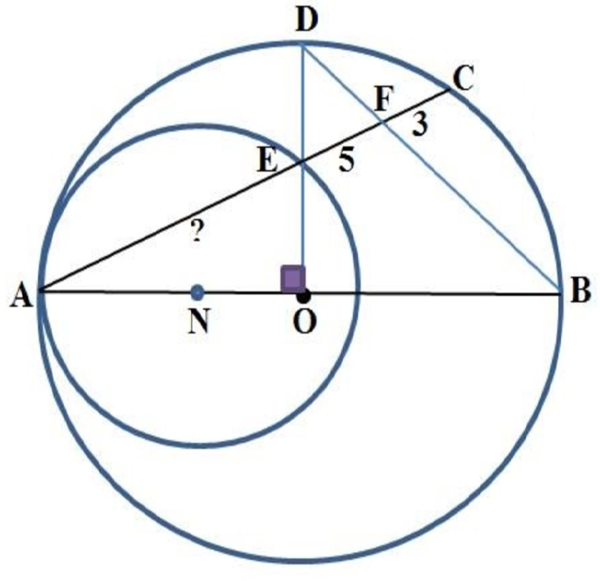two tangent circles

Two circles are tangent to each other internally with their centers and on diameter . Point on large circle is such that is perpendicular to and intersects the small circle at . is extended to intersect the large circle at . intersects at , , and . Find the length of .
The answer is 10.
This section requires Javascript.
You are seeing this because something didn't load right. We suggest you, (a) try
refreshing the page, (b) enabling javascript if it is disabled on your browser and,
finally, (c)
loading the
non-javascript version of this page
. We're sorry about the hassle.
Let A E = x , E O = d , and the radius of the large circle A O = O B = D O = r . Then d = x 2 − r 2 . Extending D O to intersect the large circle at P . Then by intersecting chord theorem, we have:
D E ⋅ E P r 2 − d 2 r 2 − x 2 + r 2 ⟹ r = A E ⋅ E C = 8 x = 8 x = 2 x 2 + 8 x ⟹ d = 2 x 2 − 8 x
Now let F Q be perpendicular to A B . We note that △ A E O and △ A F Q are similar. Then E O F Q = A E A F ⟹ F Q = x d ( x + 5 ) . Since F B = 2 F Q = x 2 d ( x + 5 ) , and D F = 2 r − x 2 d ( x + 5 ) . By intersecting chord theorem again, we have:
D F ⋅ F B ( 2 r − x 2 d ( x + 5 ) ) ( x 2 d ( x + 5 ) ) 2 ( r d x − d 2 ( x + 5 ) ) x 2 x 2 − 6 4 − ( x 2 − 8 x ) ( x + 5 ) x x 2 − 6 4 x 2 ( x 2 − 6 4 ) 1 6 x 2 ⟹ x = A F ⋅ F C = 3 ( x + 5 ) = 3 x 2 = 3 x 2 = 3 x + ( x − 8 ) ( x + 5 ) = x 2 − 4 0 = x 4 − 8 0 x 2 + 1 6 0 0 = 1 6 0 0 = 1 0